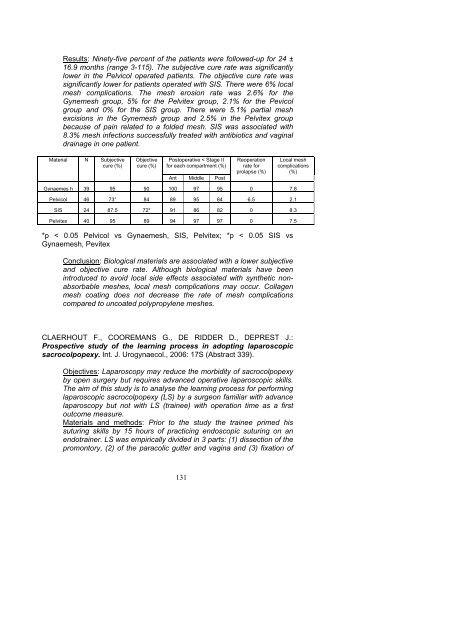2006 - UZ Leuven
2006 - UZ Leuven
2006 - UZ Leuven
Create successful ePaper yourself
Turn your PDF publications into a flip-book with our unique Google optimized e-Paper software.
Results: Ninety-five percent of the patients were followed-up for 24 ±16.9 months (range 3-115). The subjective cure rate was significantlylower in the Pelvicol operated patients. The objective cure rate wassignificantly lower for patients operated with SIS. There were 6% localmesh complications. The mesh erosion rate was 2.6% for theGynemesh group, 5% for the Pelvitex group, 2.1% for the Pevicolgroup and 0% for the SIS group. There were 5.1% partial meshexcisions in the Gynemesh group and 2.5% in the Pelvitex groupbecause of pain related to a folded mesh. SIS was associated with8.3% mesh infections successfully treated with antibiotics and vaginaldrainage in one patient.Material N Subjectivecure (%)Objectivecure (%)Postoperative < Stage IIfor each compartment (%)Ant Middle PostReoperationrate forprolapse (%)Local meshcomplications(%)Gynaemes h 39 95 90 100 97 95 0 7.8Pelvicol 46 73° 84 89 95 84 6.5 2.1SIS 24 87.5 72* 91 86 82 0 8.3Pelvitex 40 95 89 94 97 97 0 7.5*p < 0.05 Pelvicol vs Gynaemesh, SIS, Pelvitex; *p < 0.05 SIS vsGynaemesh, PevitexConclusion: Biological materials are associated with a lower subjectiveand objective cure rate. Although biological materials have beenintroduced to avoid local side effects associated with synthetic nonabsorbablemeshes, local mesh complications may occur. Collagenmesh coating does not decrease the rate of mesh complicationscompared to uncoated polypropylene meshes.CLAERHOUT F., COOREMANS G., DE RIDDER D., DEPREST J.:Prospective study of the learning process in adopting laparoscopicsacrocolpopexy. Int. J. Urogynaecol., <strong>2006</strong>: 17S (Abstract 339).Objectives: Laparoscopy may reduce the morbidity of sacrocolpopexyby open surgery but requires advanced operative laparoscopic skills.The aim of this study is to analyse the learning process for performinglaparoscopic sacrocolpopexy (LS) by a surgeon familiar with advancelaparoscopy but not with LS (trainee) with operation time as a firstoutcome measure.Materials and methods: Prior to the study the trainee primed hissuturing skills by 15 hours of practicing endoscopic suturing on anendotrainer. LS was empirically divided in 3 parts: (1) dissection of thepromontory, (2) of the paracolic gutter and vagina and (3) fixation of131

















